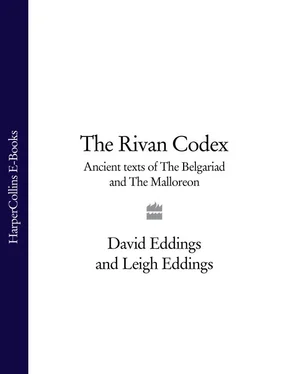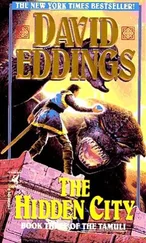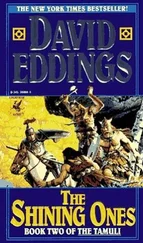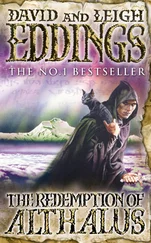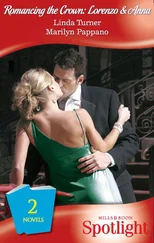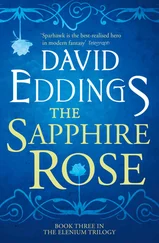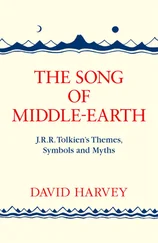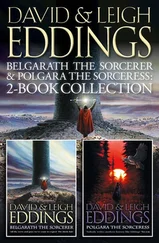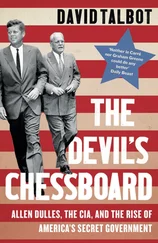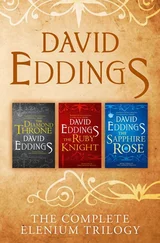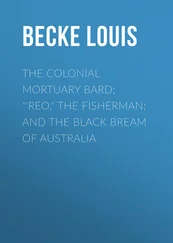Anyway, this was about the time when the ESP fakers were announcing that they could bend keys (or crowbars, for all I know) with the power of their minds. Bingo! The Will and the Word was born. And it also eliminated the Superman problem. The notion that doing things with your mind exhausts you as much as doing them with your back was my easiest way out. You might be able to pick up a mountain with your mind, but you won’t be able to walk after you do it, I can guarantee that. It worked out quite well, and it made some interesting contributions to the story. We added the prohibition against ‘unmaking things’ later, and we had a workable form of magic with some nasty consequences attached if you broke the rules.
Now we had a story. Next came the question of how to tell it. My selection of Sir Perceval (Sir Dumb, if you prefer) sort of ruled out ‘High Style’. I can write in ‘High Style’ if necessary (see Mandorallen with his ‘thee’s, ‘thou’s and ‘foreasmuche’s), but Garion would have probably swallowed his tongue if he’d tried it. Moreover, magic, while not a commonplace, is present in our imaginary world, so I wanted to avoid all that ‘Gee whiz! Would you look at that!’ sort of reaction. I wanted language that was fairly colloquial (with a few cultural variations) to make the whole thing accessible to contemporary readers, but with just enough antique usages to give it a medieval flavor.
Among the literary theories I’d encountered in graduate school was Jung’s notion of archetypal myth. The application of this theory usually involves a scholar laboring mightily to find correspondences between current (and not so current) fiction and drama to link them to Greek mythology. (Did Hamlet really lust after his mother the way Oedipus did?) It occurred to me that archetypal myth might not be very useful in the evaluation of a story, but might it not work in its creation? I tried it, and it works. I planted more mythic fishhooks in the first couple of books of the Belgariad than you’ll find in any sporting goods store. I’ve said (too many times, probably) that if you read the first hundred pages of the Belgariad, I gotcha!! You won’t be able to put it down. The use of archetypal myth in the creation of fiction is the literary equivalent of peddling dope.
The preliminaries to the Belgariad are actually out of sequence here. The Personal History of Belgarath the Sorcerer was written after the rest of the studies while I was trying to get a better grip on the old boy. You might want to compare that very early character sketch with the opening chapters of the more recent Belgarath the Sorcerer. Did you notice the similarities? I thought I noticed you noticing.
When I first tackled these studies, I began with The Holy Books, and the most important of these is The Book of Alorn. When you get right down to it, that one contains the germ of the whole story. After that, I added The Book of Torak. Fair is fair, after all, and ‘equal time’ sounds sort of fair, I guess. The Testament of the Snake People was an exercise in showing off. (A poem in the shape of a snake? Gee!) The Hymn to Chaldan was supposed to help explain the Arends. A war god isn’t all that unusual.
The Marags are extinct, but that ‘equal time’ regulation was still in place, so I took a swing at the grief-stricken God Mara. I had fun with The Proverbs of Nedra – a sort of theological justification for pure greed. Maybe I’ll make a deal with the New York Stock Exchange, and they can engrave those proverbs on the wall.
The Sermon of Aldur was a false start, since it speaks glowingly of ‘Unmaking Things’, which UL prohibited in the next section. That section, The Book of Ulgo, was rather obviously based on The Book of Job. Note that I’ll even steal from the Bible. Gorim came off rather well, I thought. Incidentally, ‘UL’ was a typographical error the first time it appeared. I liked the way it looked on paper, so I kept it. (Would you prefer to have me claim ‘Divine Inspiration?’)
I’m going to disillusion some enthusiasts here, I’m afraid. Notice that the Mrin Codex and the Darine Codex aren’t included here. They don’t appear because they don’t exist. They’re a literary device and nothing more. (I once jokingly told Lester that I’d be willing to write the Mrin Codex if he’d agree to publish it on a scroll, but he declined.) I used the ‘Mrin’ as a form of exposition. Those periodic breakthroughs when Belkira and Beltira – or whoever else is handy – finally crack the code are the things that set off a new course of action. I catch hints of a religious yearning when people start pleading for copies of the ‘Mrin’. Sorry gang, I’m not in the business of creating new religions. This is ‘story’, not ‘revelation’. I’m a storyteller, not a Prophet of God. OK?
Once The Holy Books were out of the way, I was ready to tackle The Histories, and that’s where all the ‘ologies’ started showing up – along with a chronology. When you’ve got a story that lasts for seven thousand years, you’d better have a chronology and pay close attention to it, or you’re going to get lost somewhere in the 39th century. The histories of the Alorn Kingdoms are fairly central to the story, but it was the history of the Tolnedran Empire that filled in all the cracks. You’ll probably notice how tedious the Tolnedran History is. If you think reading it was tedious, try writing it. It was absolutely essential, however, since much of the background material grew out of it.
Most of the similarities between the people of this world and our imaginary one should be fairly obvious. The Sendars correspond to rural Englishmen, the Arends to Norman French, the Tolnedrans to Romans, the Chereks to Vikings, the Algars to Cossacks, the Ulgos to Jews, and the Angaraks to Hunnish-Mongolian-Muslim-Visigoths out to convert the world by the sword. I didn’t really have correspondences in mind for the Drasnians, Rivans, Marags, or Nyissans. They’re story elements and don’t need to derive from this world.
By the time we got to the histories of the Angarak Kingdoms, we were ready to dig into the story itself, so the Angaraks got fairly short shrift. I wanted to get on with it.
There were footnotes in the original of these studies, but they were included (with identifying single-spacing) in the body of the text. These are the mistaken perceptions of the scholars at the University of Tol Honeth. The footnotes I’m adding now are in their proper location (at the foot of the page, naturally). These later notes usually point out inconsistencies. Some of this material just didn’t work when we got into the actual narrative, and I’m not one to mess up a good story just for the sake of sticking to an out-dated game plan.
The addition of The Battle of Vo Mimbre was a sort of afterthought. I knew that epic fantasy derived from medieval romance, so just to re-enforce that point of origin, I wrote one. It has most of the elements of a good, rousing medieval romance – and all of its flaws. I’m still fairly sure that it would have made Eleanor of Aquitaine light up like a Christmas tree.
I wanted to use it in its original form as the Prologue for Queen of Sorcery, but Lester del Rey said, ‘NO!’ A twenty-seven page prologue didn’t thrill him. That’s when I learned one of the rules. A prologue does not exceed eight pages. Lester finally settled the argument by announcing that if I wrote an overly long prologue, he’d cut it down with a dull axe.
Oh, there was another argument a bit earlier. Lester didn’t like ‘Aloria’. He wanted to call it ‘Alornia’!!! I almost exploded, but my wife calmly took the telephone away from me and sweetly said, ‘Lester, dear, “Alornia” sounds sort of like a cookie to me.’ (Alornia Doone?) Lester thought about that for a moment. ‘It does, sort of, doesn’t it? OK, Aloria it is then.’ Our side won that one big-time.
Читать дальше
